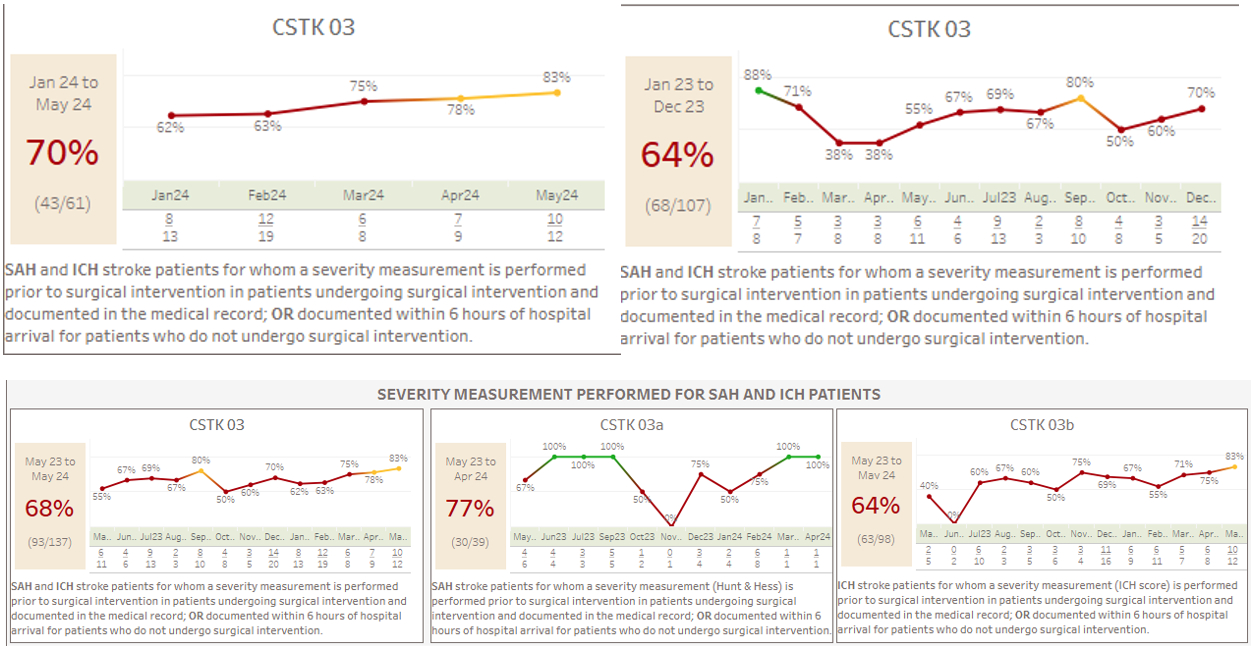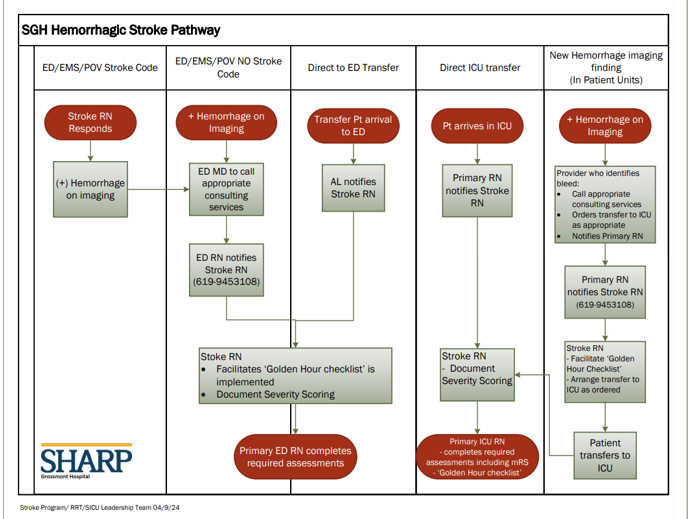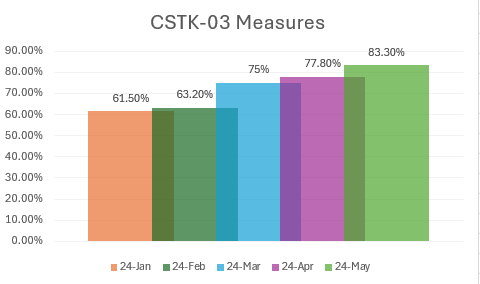Final ID: DP8
Multifaceted Approach to Improving Hemorrhagic Stroke Scoring Performance
Abstract Body: Background
Hemorrhagic stroke is associated with severe morbidity and high mortality with the progression of hemorrhagic stroke leading to worse outcomes.Early diagnosis and treatment are crucial due to the rapid expansion of hemorrhage, which can cause sudden deterioration and neurologic dysfunction.This underscores the importance of an interprofessional team in evaluating and treating hemorrhagic stroke patients.Documenting hemorrhagic stroke scoring is vital to capture the patient's clinical state, predict outcomes, and plan future care with patients, families, and providers.
Purpose
The project aims to enhance hemorrhagic stroke scoring documentation at a large comprehensive stroke center.This improvement is expected to positively affect patient outcomes.The Joint Commission mandates that comprehensive stroke centers meet all benchmark criteria to maintain certification.In the 2023 calendar year, our comprehensive stroke metric for hemorrhagic stroke scoring was at 64%, below the 'Get with the Guidelines' benchmark of 87%.To address this, we initiated a performance improvement project to emphasize the importance of hemorrhagic stroke severity scoring and to streamline the assessment and documentation process.
Methods:
The rapid response stroke nurse, who attends every code stroke, was designated to document the hemorrhagic stroke score for intracerebral or subarachnoid hemorrhages.This initiative was supported by robust nursing education and a commitment from our radiologists to document the specifications of hemorrhage.We also developed a flow diagram to manage code strokes that bypass the ED, or do not present as a code stroke.
Results
This performance improvement project began in March 2024.Current year data available from January to May 2024 shows an increased overall compliance rate of 70% from previous year of 64% with significant improvements in the intracerebral hemorrhage scoring. We continue to assess compliance and project feasibility.We are addressing challenges such as the workflow for ED patients presenting as non-code strokes and exploring solutions like targeted paging or AI software.
Conclusions
Involvement of a dedicated stroke nurse in all code strokes has been instrumental in improving hemorrhagic stroke score documentation.This has positively impacted the Joint Commission Comprehensive Stroke measure and patient care.Further review and process enhancements are necessary for non-code stroke patients diagnosed with intracerebral hemorrhage.
Hemorrhagic stroke is associated with severe morbidity and high mortality with the progression of hemorrhagic stroke leading to worse outcomes.Early diagnosis and treatment are crucial due to the rapid expansion of hemorrhage, which can cause sudden deterioration and neurologic dysfunction.This underscores the importance of an interprofessional team in evaluating and treating hemorrhagic stroke patients.Documenting hemorrhagic stroke scoring is vital to capture the patient's clinical state, predict outcomes, and plan future care with patients, families, and providers.
Purpose
The project aims to enhance hemorrhagic stroke scoring documentation at a large comprehensive stroke center.This improvement is expected to positively affect patient outcomes.The Joint Commission mandates that comprehensive stroke centers meet all benchmark criteria to maintain certification.In the 2023 calendar year, our comprehensive stroke metric for hemorrhagic stroke scoring was at 64%, below the 'Get with the Guidelines' benchmark of 87%.To address this, we initiated a performance improvement project to emphasize the importance of hemorrhagic stroke severity scoring and to streamline the assessment and documentation process.
Methods:
The rapid response stroke nurse, who attends every code stroke, was designated to document the hemorrhagic stroke score for intracerebral or subarachnoid hemorrhages.This initiative was supported by robust nursing education and a commitment from our radiologists to document the specifications of hemorrhage.We also developed a flow diagram to manage code strokes that bypass the ED, or do not present as a code stroke.
Results
This performance improvement project began in March 2024.Current year data available from January to May 2024 shows an increased overall compliance rate of 70% from previous year of 64% with significant improvements in the intracerebral hemorrhage scoring. We continue to assess compliance and project feasibility.We are addressing challenges such as the workflow for ED patients presenting as non-code strokes and exploring solutions like targeted paging or AI software.
Conclusions
Involvement of a dedicated stroke nurse in all code strokes has been instrumental in improving hemorrhagic stroke score documentation.This has positively impacted the Joint Commission Comprehensive Stroke measure and patient care.Further review and process enhancements are necessary for non-code stroke patients diagnosed with intracerebral hemorrhage.
More abstracts on this topic:
Automated Identification of Stroke Thrombolysis Contraindications from Synthetic Clinical Notes
Chen Bing Yu, Hussain Muhammad, Gonzalez Marco, Antaki Fares, Delora Adam, Aube Eric, Albahra Samer, Robertson Scott, Uchino Ken, Russman Andrew
Advanced Practice Provider Achieves Quicker Door to Needle Time than Neurology ResidentsStaltari Concetta, Noah Patty, Heintz Rebekah, Hackett Chris
Readers' Comments
We encourage you to enter the discussion by posting your comments and questions below.
Presenters will be notified of your post so that they can respond as appropriate.
This discussion platform is provided to foster engagement, and simulate conversation and knowledge sharing.
You have to be authorized to post a comment. Please, Login or Signup.
Rate this abstract
(Maximum characters: 500)



